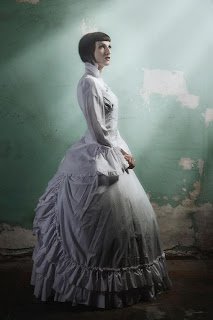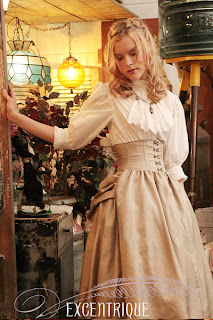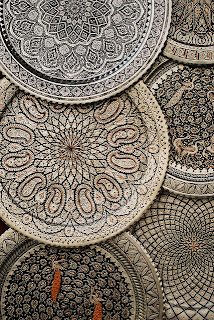In an
earlier post, I promised an explanation of how I wash my natural fibers. I am beginning to collect quite a few different pieces of 100% something or the other, only because I have overcome my fear of ruining those pieces in the wash- a fear which seems common to many people browsing the thrift store. This will not be an exhaustive tutorial of how to washing things- and if any of it is incorrect, please let me know before its too late. It's simply what has worked for me in the past.
If it is laundry day and the pile of clothing looms threateningly, do not- I repeat- do not just throw it all into the washer and run away. Different fabrics require different care depending on how they are created at a microscopic layer. Wool, for instance, is the hair of a sheep. And like our hair is comprised of tiny scales. When these strands are heated, the scales spring open and latch on to each other. If the fibers are then agitated, these newly formed teeth reach out and claw across each other, sticking and tangling- so when you pull your sweater out of the wash (which is designed to heat and agitate fabrics) it's the shape remains but about twenty sizes too small because of how the fibers compacted. Hence horror stories of ruined wool items.
But fear not- this need not be the fate of all garments.
First, look at the inside tag of each and ever item. These are put on by the makers who generally have a decent idea about how their item should be handled. If it says wash in cold, put in a cold pile. If warm, put in a warm pile.Never the two shall mix. It is surprising how many natural fibers can stand up to the washing machine- I have cashmere sweaters that like warm and cotton that likes hot.
If the tag says dry clean- it's a suggestion- not a commandment carved in stone.Put it to the side for the moment.
If the tag says dry clean ONLY- you're in a dilemma The most common reason for this concern is that the item has a, generally, wool exterior and a silk or polyester lining. If you wash the wool in warm, it will shrink. If you wash the polyester in cold, it won't be washed. Dry cleaners- through magic I know not- are able to circumvent this problem. I've come up with three possible solutions:
~ If you have the money, want to ensure the life span of the piece, or just bought it from the thrift store, take it to the dry cleaners.
~ If you are a broke grad student like me and are ambivalent about necessary cleanliness or lifespan of the piece, put it in the pile with the other dry clean pieces.
~ If you are hard core, remove the lining from the item, wash each separately, and, I guess, resew them together afterwards.
Now, look to the much smaller pile of dry clean garments. What you need now is a bath tub, some mild detergent and many, many, many towels. A spare room is also useful. Or understanding room mates.This technique is especially recommended for Grad students because the steps are far enough spaced that you can get a good chunk of studying finished between each.
First, fill up the bath tub with cold- it must be cold- water. Add a bit of detergent. Let the detergent soak in and then carefully add your sweaters and other things. If you are terribly conscientious, separate colors from whites from black. Fill the tub so that all the sweaters are submerged.
Do not scrub the sweaters.
Do not swish them about.
Do not mix them up, turn them over, attempt to reenact the parting of the red seat, etc.
Do squish them down lightly until they are submerged. Do gently press down on them- careful not to agitate the fibers. Do work any particularly dirty spots generally. (For actual stains, consult the internet.)
Let them soak in the water for as long as it takes you to memorize another chapter, then drain the water, fill the tub up again, and soak. This is the rinsing phase.
Once, you feel the detergent sufficiently rinsed, drain and leave the sweaters in there for a while. Press gently on them to remove some of the excess water, but let most of it drain out through gravity.
Here is where the towels come into play. After the sweaters are washed, rinsed, and drained, pick them up gently and, without squeezing, wringing or twisting, lay them flat on a towel. Yes, they will be heavy and soaked. Roll the towel up, squeeze out the excess water and transfer the sweater to another towel in another room. It will take about two days to dry fully (see what I said about understanding room mates) check twice a day to turn the sweater over and change out the towel underneath.
This would be an excellent time and place to put all those other clothes to dry. For, as you were reading the labels you'll notice that about half of those clothes that can go into the dryer ask to be either line dried or dried flat. Listen to those requests! It is the hot air and the tumble drying that wear out clothes so fast. Plus, by air drying, you are saving electricity on your bill.
If a garment is knitted rather than woven, it will most likely be asked to be dried flat. If you try to dry it on a hanger, the garment is going to lose its form and you'll end up with awkward bumps on the top of the shoulder. Most unsightly. Lay these out on a towel as well and they should be dried with in a day or two.
Those with tags that say tumble dry low, can be tumble dried low with just about everything else that is left over.
Now, you are still not quite finished. After everything has dried out, pick up your iron and ruin it quickly over your linens, cottons and any wool that are wrinkled. Pay attention to the tag not the iron settings. Another annoying thing about synthetic fibers is that you can't iron them without turning them into plastic. Natural fibers can be ironed and have that lovely, crisp quality. Then hang everything in the closet right away rather than keeping it piled on your floor. After all that work, it would be a shame not to put things away properly.
Do you see why washer women were so Vital to the Victorians?
Much like this post, laundry can seem enormously challenging. But it's not. All told, it is maybe three hours of work spread out over two days time. Getting up to change the laundry, turn over the sweaters or iron a few shirts is a great study break and can calm the mind while the hands remain busy. Plus, the next time that you put on your sweater, skirt, shirt or otherwise, you know that you are wearing something of great personal value.
If anyone has tips, tricks or questions, I'd love to hear them. Again, if it seems I am doing something wrong, let me know.









































